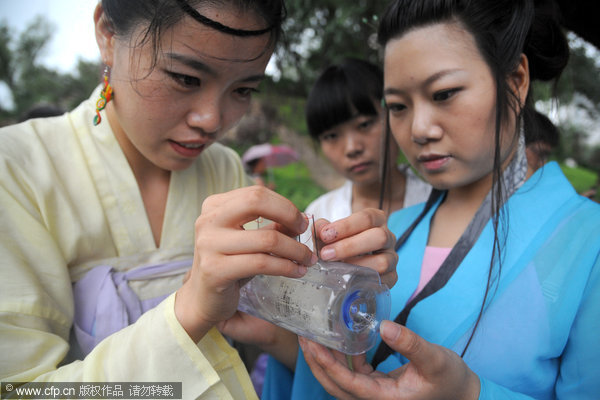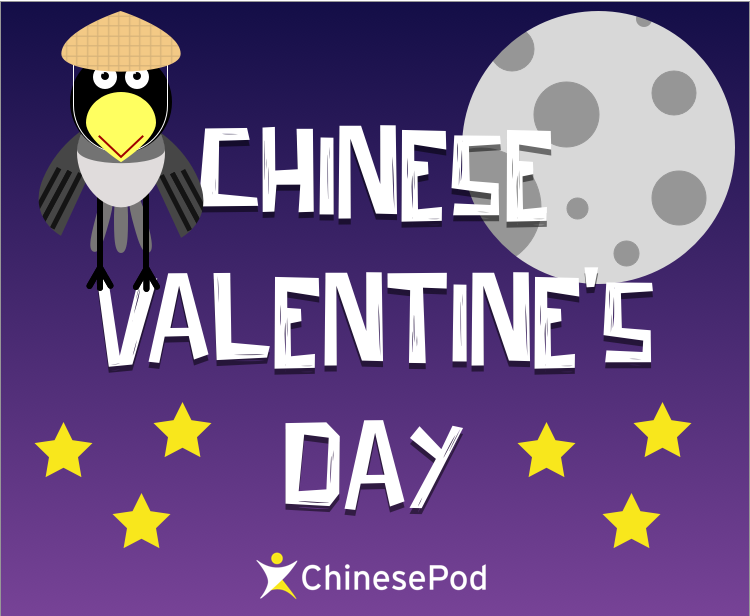Chinese Valentine’s Day: Not the V-Day You Know and Love (or Hate!)
When you think of Valentine’s Day, you probably think of roses, chocolate, heart decor everywhere.… or the alternative: a bitter hatred of the holiday and all the sappy reminders of love around you.
So you are probably wondering: what the heck is up with Chinese Valentine’s Day? Why does the picture above have a bird on it against a starry sky? Well for starters: throw your understanding of Western Valentine’s Day out the window. Chinese Valentine’s Day doesn’t take in February. It take’s place on the seventh day of the seventh moon of the Lunar Year… or today, August 20th, 2015. The holiday is rich with mythology and tradition, with an origin tale dating back two thousand years ago to the Han Dynasty.
Read to learn why this holiday take place, how Chinese Valentine’s Day is celebrated, and key vocabulary for the day.
The Tale
The tale begins when the Seven Daughters of the Goddess of Heaven decide to come down to Earth for some fun. Once they arrive, the Seven Fairies decide to take a swim in a brook.
Meanwhile, a cowherd, named Niu Ling, attends to his daily duties of working on his family’s farm with their old Ox. To his surprise, the old ox speaks to him — it turns out the ox is an immortal from heaven who was exiled to earth after pissing off the Emperor of Heaven one too many times. The Ox tells Niu Ling, “You are a friendly person. If you wish to get married to a beautiful lady, you must head to the local brook immediately.” With this advice, Niu Ling heads to the brook where he finds the daughters bathing. His gaze fixates on the most beautiful of the daughters: the seventh and youngest, named Zhinu. Zhinu is known as a weaving maid, using her skill to weave silken white clouds and vividly prismatic rainbows, and her talent is reflected in her natural beauty.
Stealing Zhinu’s fairy clothes so she can’t fly away, Niu Ling returns home. When the sisters decide they’ve had enough of earth, they go to put their clothes back on and fly back home. Zhinu, missing her clothes is not able to return to heaven, and the sisters leave her behind (how rude is that!). At this point, Niu Ling shows up and gives her an ultimatum: either marry me or else you don’t get your clothes back. Zhinu hesitates, but eventually agrees to take the cowherd’s hand in marriage.

Niu Lang and Zhinu hanging out with the Heavenly Ox. Source: http://beijing.english.china.org.cn/
The cowherd and the seventh fairy daughter end up living happily together for two years, having two children along the way. Meanwhile, Zhinu’s mother is irritated: the skies no longer have the sumptuous colours and glow now that Zhinu has stopped weaving on her empyrean looms. So mom decides what all irritating moms do: no more fun, it is time to come home! She orders Zhinu to return to her celestial home… or else. Zhinu reluctantly flies home, leaving behind a forsaken Niu Ling.
The exiled Ox/Spirit speaks to the inconsolable Niu Ling once again: “Kill me, take my heavenly hide and you will be able to make your way up to heaven and be reunited with your wife once again.” Niu Ling does just that, wrapping the befallen Ox’s hide around himself and the two children, and begins to make the way his way up to heaven, crying bitterly over the death of the Ox. The Heavenly Goddess hears the sobs of Niu Ling and plucks her hairpin out, scratching it across the stars creating a “river” that separates the two lovers. Zhinu must sit forever on one side of the “river”, tearfully weaving her looms on Vega, a star apart of the Lyra constellation. Meanwhile, Niu Ling sits with his children on the other side of the river, on the star of Altair, apart of the Aquila constellation.
Magpies, moved by the true love of Niuling and Zhinu, are permitted by the Goddess of Heaven to come up only once a year, on the seventh day of the seventh moon, and build a bridge between Vega and Altair for the two lovers to reunite for twenty-four hours.

The Lovers Unite in the Heavens during their annual embrace. Source: http://nacholaqueado.blog.com/
Legend has it that if it rains on the seventh day of the seventh moon of the year, the lovers have been crying during their annual embrace.
The Traditions
Chinese Valentine’s Day is especially popular for young girls, who worship the celestials at local temples, praying to Zhinu for wisdom, dexterity in needlework, and a good and loving husband that they can marry one day. It is also quite popular to leave toiletries at shrines in honour of the seven sisters.
Because of Zhinu’s weaving abilities, girls often participate in contests where they attempt to thread needles in low-light conditions, such as a glowing ember (how fun does that sound?).

Girl’s trying to thread multiple needles in a row on Chinese Valentine’s Day. Source: http://africa.chinadaily.com.cn/
This festival is also important for newlywed couples. They worship the star-crossed lovers one last time and bid farewell to them, which is symbolic of a happy marriage between the newlyweds.
On the eve of the seventh day of the seventh moon of every lunar year, the Chinese gaze up at the sky, looking for Vegas and Altair shining, with a third star forming the symbolic bridge between the two stars.
The Key Vocabulary
Seventh of July
七夕节 | Qīxì jié
Qi Qiao Festival
乞巧节 | Qǐqiǎo jié
Married Couple Becomes Old Together With Each Other (No Divorce)
白头偕老 | Báitóuxiélǎo
A Perfect Marriage
美满姻缘 | Měimǎn yīnyuán
Weaver Girl
织女 | Zhīnǚ
Cow Herder
牛郎 | Niú Láng
Magpie
喜鹊 | Xǐquè
Magpie Bridge
鹊桥 | Quèqiáo
If you found this article interesting, we think that you’ll love ChinesePod! We have tons of Cultural and Historical lessons for skill levels ranging from Newbie all the way to Advanced. Click the banner below to subscribe and enter promo code “LearnChinese” for an exclusive offer!
Karl Ryan
Latest posts by Karl Ryan (see all)
- 7 Apps That Can Score You a Date in China - July 5, 2016
- 22 Things You Can Burn for Qing Ming Festival - March 30, 2016
- Speak the 3rd Tone Like a Native: Say It Like a Kardashian - March 24, 2016



